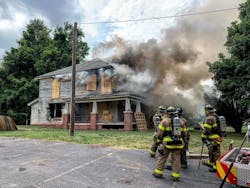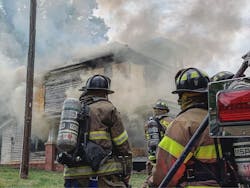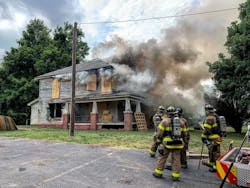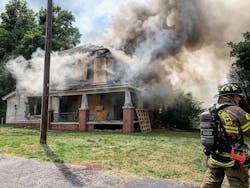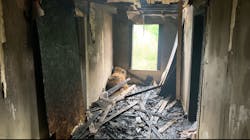Close Calls: North Carolina Live-Fire Drill-Part 2
Our sincere thanks to Chief of Department Bob Parnell, Battalion Chief Nick Martin, Division Chief David Morris, Captain Brantley Shanks, as well as all the members of the SFD who have contributed to sharing the facts of their live-fire drill. As detailed in Part 1, the history of NFPA 1403 goes back to a 1982 training detail in Boulder, CO, where two firefighters died in the line of duty (training) and another suffered severe burn injuries during their training incident. While the NFPA 1403 standard clearly outlines all aspects of the burn tasks, here is a brief outline to give you an idea of the steps:
Documentation
- Contracts for outside instructors, building preparation personnel, or general contractors
- All students to be certified to FF1 level prior
- PPE/gear to be in good condition, documentation of inspections
- Pre-burn plan to include evacuation plan, water supply calculations, and fuel load calculations
- Jurisdictional permits required
- Ownership determination, release and property transfer
- Clear title
- Written permission to burn
- Anticipated condition of structure at end of burn
- Method of property return to owner
- Proof of insurance cancellation/statement
- Post-training critique and final report
Personnel
- Minimum of seven certified live-fire training instructors
- Instructor-in-charge (IIC)
- Safety Officer
•instructor per functional crew
• instructor per backup line
• instructor per functional assignment
• ignition officer/fire control team
• ignition observer assistant/fire control team
- Pump operator(s)
- Rehab area staffing
- BLS medical personnel and
- transport unit
- Rapid intervention crew/team
Site Prep
- Determine suitability of building for live-fire training use
- Prepare building for burning (make repairs, cover holes, remove hazards, etc.)
- Protect or remove adjacent properties
- Hazard mitigation
- Clean-up
- Removal/disposal
- Repairs
- Asbestos removal
- Vegetation/vermin abatement
- Utilities to be disconnected (to the burn structure) and removed or protected (adjacent structures)
- Run-off containment
Burn Day
- Accountability (PAR) system in place and managed
- Weather observed to ensure safe conditions
- Rehab station and supplies established
- Communications and radios provided
- Evacuation plan and signal demonstrated
- BLS medical transport unit onsite
- Adequate and reliable water supply available
- Calculate needed supply (NFPA 1142)
- Ensure reliability of primary/backup lines (95 gpm)
- Ensure adequate minimum water reserve
- Ensure clear space around structure for operation of hoselines
- Fuel materials available
- Amount and type (wood-only)
- Documentation/calculation of fuel loading
- Removal of additional potential ignition sources and unidentified materials
- Parking and staging areas designated
- Apparatus used for training
- Parking for spectators/press
- Designate ingress/egress routes
- Brief the pre-burn plan
Maintain the following records
- Accounting of all activities conducted
- List of instructors/assignments
- List of all participants
- Documentation of unusual conditions encountered
- Injuries incurred/treatment provided
- Changes or deterioration to the structure
- Documentation of condition of structure and surrounding area at end of training
- Conduct a post-training critique
As you can see, unlike “the old days,” a significant amount of preparation must be completed prior to the burn. Actually, it’s not that much different than a fire department being fully prepared for a fire, only there is absolutely no rush when conducting a training burn because training preparation is the focus.
Firsthand accounts
The following accounts are from the firefighters involved in the SFD live-burn detail.
Captain Brantley Shanks
When I arrived “on scene,” I exited the cab and made a 360 of the structure. There was heavy black smoke coming from the A-side window. When I returned to the A side, light gray smoke was beginning to come from the A and B corner windows. This gave me an idea that the fire was in the A-B corner room on the second floor.We entered the structure. With me were a nozzle firefighter and a slack firefighter on a 1¾-inch hoseline. On the first floor we had no heat and clear air. As we started up to the second floor, we were met with thick black smoke on the landing. The plan from the get-go was to begin flowing water as soon as we made the fire floor to cool the hot environment. The smoke lit off with my firefighter on the top step and we encountered heat and a brief flash. As soon as the smoke lit off, my nozzle firefighter opened the nozzle and began flowing water. We encountered our mannequin victim almost simultaneously with the smoke lighting off and I passed the victim to a company that was behind us on the steps. My nozzle firefighter flowed water and we advanced the line to the fire room and extinguished the fire.
From the inside, the incident was much less impressive, and we had no idea that the fire made such a show from the outside. The video we saw after we were finished with our evolution was very surprising.
Division Chief D.H. Morris
On June 6, 2019, a live burn was conducted at 1435 Bringle Ferry Rd. The house was a two-story farmhouse built in 1924 and constructed of wood framing. The interior contained wood floors, bead board ceilings and walls along with plaster overlay in some rooms. An asbestos/lead inspection of the house was ordered and conducted pre-burn and all items containing asbestos or lead were removed from the structure, including windows.Prior to the burn, on May 29, Chief Nick Martin and I purchased and placed oriented strand board (OSB) over the windows. OSB is a type of engineered wood similar to particle board, formed by adding adhesives and then compressing layers of wood strands in specific orientations. It’s been around since 1963.
The OSB was placed on the outside of the windows for easy removal by ventilation crews inside and out. The SFD live-fire policy was also reviewed and rotations for burns to include a live-fire instructor, stoker, incident commander (IC) and safety officer was established for each burn. Fire loads for each burn room were determined to include two bales of straw and four to five pallets. Arrangements for the rescue squad to provide a medical transport unit during the burn were also confirmed.
On June 6, the day of the burn, the live-fire instructors, including Dale Brown and Josh Johnson as well as Battalion Chief Martin and myself, evaluated the structure and discussed the burns planned for the day. We added additional sheets of OSB to the upstairs doors to help contain the fire to the primary room of origin. Finishing nails were used to hold boards in place and approximately two to three nails per board were used. The coverings were inspected for ease of removal. We also reviewed and identified multiple points of egress including the porch roof. An instructor safety line was placed in-service on the Charlie side of the building and the dormer windows served as a ventilation point.
Prior to the burn, Martin conducted a pre-burn review of the scenarios with all participating members. A walk through was conducted for all members as crews prepared for the exercise. Each scenario was set up to include four engine companies, two ladders and a battalion to serve as the IC.
The first scenario was set up with a burn in the front bedroom on the Alpha/Bravo side of the structure. Two rescue dummies were placed inside, one at the (landing) of the second floor and the other in the front living room on the Alpha/Delta side. Once the fire was lit, time was given to allow the fire to develop to a suitable point (based on live-fire instructors’ directions). Once the word was given for crews to move forward, companies were assigned in pairs at 20/30-second intervals.
As the fire progressed, the primary engine stretched a line to the Alpha-side front door. I remained on the stairs as the live-fire instructors continued to monitor and stoke the fire. I maintained a clear visual with them and provided updates on the progress of the first engine’s movement stretching the line and entering the building (92 seconds). As the first engine made their way to the fire, I moved to the bottom of the landing as the live-fire instructors retreated to the open window that led to the porch roof. This was a planned position for the instructors to take to prevent the hallway from being clogged as crews made their way to the fire room. Jim Squiterri (a Charlotte firefighter assisting the SFD) followed the hose team in to help evaluate their hose and nozzle skill set. I followed the team back up the stairs as they made contact with the first victim (rescue dummy), and as they handed the victim off and began flowing water down the hall (moderate heat and a red glow was present) I moved back. As the dummy was passed down, I relocated to the first floor to evaluate other operations, including (search) operations by the truck company and the back-up line (holding the stairs).
At some point, Chief 50 contacted me to ask if we were okay and I confirmed we were all good. Other than heavy smoke, moderate heat and the red glow, I was unaware an event (smoke explosion/flash fire) had occurred. All interior crews continued to operate normally during the incident, and it was not until after extinguishing the fire and exiting the structure that we learned of the rapid-fire growth that occurred. At no time did I believe the interior crews were in danger.Points of interest:
- Fuel load consisted of two bales of straw and four pallets
- Boards were attached to the outside using 1½-inch finishing nails for ease of removal
- Two points of egress were maintained upstairs and two were maintained downstairs
- A primary attack line was pulled as was a back-up line. In addition, the FAST Team pulled a line and a pre-positioned line was put in place on the Charlie side for the instructors (separate water supply)
- Ventilation was accomplished by leaving the dormer windows on the Alpha side uncovered. In addition, the hallway window was left open for the instructors
- Two live-fire instructors were assigned to lighting and stoking the fires. They maintained visual contact with the fire attack team from the porch window on the second floor. Squiterri and I maintained contact with the companies as they progressed interior
- Battalion 1 served as the IC and Chief 50 served as the outside safety officer. A division officer was assigned to the second floor to coordinate the functions of fire attack, search and extension.
Final comments
This two-part article speaks for itself. The department understood the seriousness of live-fire training, as well as the value, and took the required steps to ensure their preparedness ... especially when a predicable event occurs. Use this as an important example of live-fire training.
I want to end with one final thought that isn’t as much about training as it is about understanding the big picture. I often equate fire operations with a football team’s operations as a vague comparison related to our specific roles, responsibilities and communication. Notice in the above accounts that members operating inside did not realize what conditions looked like on the outside. That’s a big deal!
In football, there is the coach (IC) and then there are “assistant coaches” around the field all observing, communicating and following the game plan. The assistant coaches “see” things that the others (on and off the field) may not see, and if critical, they share that information.
On the field, the quarterback and the players (division supervisor and firefighters) see things that the coach (IC) and assistant coaches don’t. This all brings home the point that, for us to have success, we must fill all the required positions to minimize risk to those operating on the training ground, and the fireground.
Just like in football, you must fill all roles (live-fire training as well as actual fire response) to assure a “level” playing field. The fireground also requires positions filled (water supply, forcible entry, line stretching, water on the fire, search, vent, rescue, command and supervisory positions) if we have a fighting chance to “win.” Having all the roles and duties covered helps minimize the opportunity for those operating in one part of the fire (interior and outside) to not understand what’s happening elsewhere.
To be clear, while I compare fire and football, what you and we do as firefighters is absolutely no game. And the fire scene (or playing field) is definitely not even. We start off losing and must win. The good news is that we all know that fact and we can work hard in training and related preparedness to assure we have qualified and fast staffing, so that we, and more important, those who called 9-1-1, have a decent shot of surviving.
About the Author
Billy Goldfeder
BILLY GOLDFEDER, EFO, who is a Firehouse contributing editor, has been a firefighter since 1973 and a chief officer since 1982. He is deputy fire chief of the Loveland-Symmes Fire Department in Ohio, which is an ISO Class 1, CPSE and CAAS-accredited department. Goldfeder has served on numerous NFPA and International Association of Fire Chiefs (IAFC) committees. He is on the board of directors of the IAFC Safety, Health and Survival Section and the National Fallen Firefighters Foundation.
